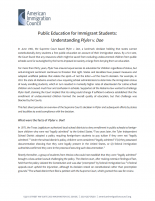- Fact Sheet
Public Education for Immigrant Students: Understanding Plyler v. Doe
Published
In June 1982, the Supreme Court issued Plyler v. Doe, a landmark decision holding that states cannot constitutionally deny students a free public education on account of their immigration status. By a 5-4 vote, the Court found that any resources which might be saved from excluding undocumented children from public schools were far outweighed by the harms imposed on society at large from denying them an education.
For more than thirty years, Plyler has ensured equal access to education for children regardless of status, but anti-immigrant sentiment continues to threaten that right. States and localities have passed measures and adopted unofficial policies that violate the spirit—if not the letter—of the Court’s decision. For example, in 2011 the state of Alabama enacted a law requiring school administrators to determine the immigration status of newly enrolling students, which in turn resulted in markedly higher rates of absenteeism for Latino school children and caused much fear and confusion in schools. Supporters of the Alabama law wanted to challenge Plyler itself, claiming the Court implied that its ruling could change if sufficient evidence established that the enrollment of undocumented children harmed the overall quality of education, but that challenge was blocked by the Courts.
This fact sheet provides an overview of the Supreme Court’s decision in Plyler and subsequent efforts by states and localities to avoid compliance with the decision.
What were the facts of Plyler v. Doe?
In 1975, the Texas Legislature authorized local school districts to deny enrollment in public schools to foreign-born children who were not “legally admitted” to the United States. Two years later, the TylerIndependentSchool District adopted a policy requiring foreign-born students to pay tuition if they were not “legally admitted.” Under the school district’s policy, children were considered “legally admitted” if (1) they possessed documentation showing that they were legally present in the United States, or (2) federal immigration authorities confirmed they were in the process of securing such documentation.
Shortly thereafter, a group of students from Mexico who could not establish that they were “legally admitted” brought a class action lawsuit challenging the policy. The district court, after making extensive findings of fact, held that the policy violated the Constitution and was also “preempted” by federal immigration law. A federal appeals court upheld the injunction, although its decision rested on constitutional rather than preemption grounds. The school district then filed a petition with the Supreme Court, which granted the case for review.
What was the basis for the Supreme Court’s ruling?
The Court based its ruling on the Fourteenth Amendment of the U.S. Constitution, which says in part, “No State shall … deny to any person within its jurisdiction the equal protection of the laws.” (This provision is commonly known as the “Equal Protection Clause.”) Under this provision, the Court held that if states provide a free public education to U.S. citizens and lawfully present foreign-born children, they cannot deny such an education to undocumented children without “showing that it furthers some substantial state interest.”
The Court found that the school district had no rational basis to deny children a public education based on their immigration status, given the harm the policy would inflict on the children themselves and society as a whole. “By denying these children a basic education,” the Court said, “we deny them the ability to live within the structure of our civic institutions, and foreclose any realistic possibility that they will contribute in even the smallest way to the progress of our Nation.” The Court also said that holding children accountable for their parents’ actions “does not comport with fundamental conceptions of justice.”
Did the dissent suggest that undocumented children should be prevented from attending school?
No. To the contrary, the dissent acknowledged that it “is senseless for an enlightened society to deprive any children—including [unauthorized immigrants]—of an elementary education,” in part because “the long-range costs of excluding any children from the public schools may well outweigh the costs of educating them.” Instead, the dissent argued that the Court should defer to the school district’s policy because the Constitution does not officially prevent discrimination against unlawfully present immigrants.
Did the Court say its opinion would change if evidence existed that educating undocumented children reduces the quality of education for other students?
No. The majority noted that the record in the case did not support “the claim that exclusion of undocumented children is likely to improve the overall quality of education in the State.” However, the remark was not central to the Court’s reasoning or otherwise intended to leave open the question. The Court also said that even if barring one group of children from schools was likely to improve the overall quality of education, the school district would still have to justify applying the prohibition to undocumented children. Thus, there is no basis to believe the Court’s decision would have been different—or that a future Court would overrule Plyler—if evidence showed that educating undocumented school children reduces the quality of education for other students.
How have states and localities attempted to circumvent the Plyler decision?
In the three decades since the Plyler ruling was issued, states and localities have passed numerous measures and adopted unofficial policies that violate the spirit if not the letter of the decision. For example:
- In 1994, California voters enacted Proposition 187, which prohibited public elementary and secondary schools from admitting any student who was not lawfully present in the United States, and which required schools to notify federal immigration authorities within 45 days of any student reasonably believed to be in violation of federal immigration laws. The measure was subsequently struck down in federal court for violating Plyler.
- In 2006, the school district in Elmwood Park, Illinois, denied enrollment to a student who had overstayed the tourist visa on which he had originally entered the country. The district ultimately permitted the student to enroll, however, after the Illinois State Board of Education threatened to withhold funding.
- In 2011, the Alabama legislature enacted a measure requiring school administrators to determine the immigration status of all newly enrolling students, and to submit an annual report to the state Board of Education setting forth all data obtained under the requirement. The federal government and numerous private plaintiffs have sought to enjoin this provision as part of a larger challenge to H.B. 56, the omnibus measure in which it was enacted. A federal district court in Alabama declined to enter a preliminary injunction against the provision upon finding that none of the plaintiffs had standing to appeal. However, a federal appellate court subsequently blocked implementation of the provision pending resolution of an appeal. The provision was permanently blocked in October 2013 when Alabama agreed to a settlement in the lawsuit.
In addition to formal measures, local school districts have routinely adopted unofficial policies designed to circumvent Plyler. For example, schools have required immigrant students or parents to submit Social Security numbers or provide other additional documents prior to enrollment. In a “Dear Colleague” letter sent in May 2011, the Department of Education and the Department of Justice reminded school administrators that they may not deny enrollment to students who are unwilling or unable to provide a Social Security number, or who provide a foreign birth certificate at the time of enrollment.
Why should schools be prevented from collecting and reporting information on students’ immigration status?
Even if schools permit undocumented children to enroll, collecting and reporting information about their immigration status is bad policy and also likely unconstitutional. Although the stated intent of such measures may be to obtain an accurate count of the number of undocumented schoolchildren, their implementation may dissuade immigrant families from enrolling their children in the first place. According to figures provided by the state of Alabama, for example, more than 13 percent of Latino students in the state withdrew from public schools between September 2011 and February 2012—even though immigrants as a whole constituted less than 0.5 percent of students in Alabama schools. Thus, the apparent effect of such measures is to deter enrollment of children with undocumented parents or other family members, even if the children are themselves U.S. citizens.
In addition to causing higher rates of absenteeism, measures like Alabama’s require untrained school administrators to make complicated determinations about immigration status; erode immigrant students’ trust of teachers, counselors, and other school employees; create greater potential for racial and ethnic profiling; and can breed conflict amongst students themselves, such as the bullying of students who are (or are perceived to be) foreign-born. Such measures can also lead to potential violations of the Family Educational Rights and Privacy Act (FERPA), which prevents schools from disclosing information in student files without parental consent.
Help us fight for immigration justice!
The research is clear – immigrants are more likely to win their cases with a lawyer by their side. But very few can get attorneys.
Introducing the Immigration Justice Campaign Access Fund.
Your support sends attorneys, provides interpreters, and delivers justice.

Immigration Justice Campaign is an initiative of American Immigration Council and American Immigration Lawyers Association. The mission is to increase free legal services for immigrants navigating our complicated immigration system and leverage the voices and experiences of those most directly impacted by our country’s immigration policies to inform legal and advocacy strategies. We bring together a broad network of volunteers who provide legal assistance and advocate for due process for immigrants with a humane approach that includes universal legal representation and other community-based support for individuals during their immigration cases.

